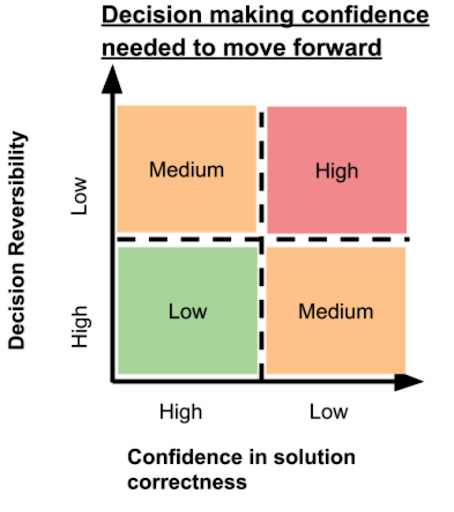Stated confidence strength: Without stating confidence strength others often assume your confidence is high.
Reading time: 5 mins
Summary:
I’ve found it better to explicitly state Confidence Strength than not. E.G I have a low confidence view this will improve education outcomes. E.G. I have a high confidence view this will improve onboarding metrics because of 10 user observations.
Everything can't be of equal confidence.
The work required to have high confidence is high.
IMO default should be low confidence.
Dunning Kruger = Overconfidence = 1. Confidence you have - 2. Confidence you should have.
Jingle:
Assumption is the mother of all eff ups.
Overconfidence is assumption’s mother.
Therefore overconfidence is the grandmother of all eff ups.
Ways to state Confidence Strength
Option 1: Low vs Medium vs High Confidence Strength.
EG 1.
Recommended: I have low confidence about Attribute A being a weakness for Person X. I’ve only seen it happen twice.
Not recommended: I think person X is bad at Attribute A.
EG 2.
Recommended: I have high confidence about Attribute A being a weakness for Person X as I’ve seen it 6 times now in multiple circumstances.
Not recommended: I think person X is bad at Attribute A.
Option 2: Percentage: normally 10%, 25%, 50%, 75% or 90% confidence.
EG 1.
Recommended: I have 10% confidence this will improve the onboarding experience. I recommend we do 5 user interviews next to increase confidence before possibly recommending to build.
Not recommended: I think this will improve onboarding.
EG 2.
Recommended: I have 90% confidence this is hurting retention because I’ve conducted a Google Forms survey with the students from 5 schools and this is the #1 thing the students don’t like.
Not recommended: I’m worried about this area of the product.
++++++++++
Details
Facts vs Opinions
This is an oversimplification, but let’s just say there are two categories of things: facts and opinions.
One can be categorical about facts, but categorically one shouldn’t be certain about opinions!
Fact = EG today is Friday. EG the coffee costs $4.
Opinion = Eg how to spend a friday well. EG how to make the best coffee.
For opinions at work, I think it’s best to state your Confidence Strength.
“Uncertainty is not a pleasant condition, but certainty is absurd.” Voltaire.
Only a fool is 100% certain about non facts (opinions).
Confidence sufficiency - Only do things above confidence sufficiency
Related blogs:
Decision making confidence needed = Confidence sufficiency = 1. Reversibility of decision * 2. Confidence of solution being correct.
The Confidence Strength needed to move forward on a decision varies. Some decisions you can move forward with low Confidence Strength, other times you need high Confidence Strength.
Work is required to build confidence
You normally start off with low confidence. If you want to do the work you can build to high confidence, but ultimately you should probably still have low confidence until you have external data to support your opinion.
This stat about A/B testing from AirBnB is a fav.
“Of these experiments, 92% failed to improve the metric that we were trying to move. So only 8% of our ideas actually were successful at moving the key metrics.”
AirBnB is widely regarded as having a very good Product Organisation.
If AirBnB were only right 8% of the time, then if you were recommending changes as part of that AirBnB on average your confidence about being ‘correct’ should have been 8% AKA low.
I’m reasonably confident that the people putting forward the recommendations would have thought they were going to move the metric in a positive direction more than 8% of the time.
I remember thinking that 50% of my recommended changes should be an improvement and 50% worse as a starting point. Not 8%!
I’ve come to believe that thinking on average 50% of recommendations are an improvement is wildly optimistic.
I now believe that you should only have high confidence something is an improvement if you have externally validated it with users.
Dunning Kruger = Overconfidence
Dunning Kruger EG = Having 50% confidence when you should have 10% confidence.
Being ‘senior’ and somehow thinking that you know things when you haven’t done the work to have high confidence is a classic example of overconfidence.
Assumption is the mother of all f-ups.
Overconfidence is the mother of all assumption.
Therefore Overconfidence is the grandmother of all f-ups.
I’ve found that stating your Confidence Strength is a really good way to try to stop yourself from having overconfidence.
But also if you don’t state your Confidence Strength others can often think you have high confidence in what you are saying when perhaps you don’t have high confidence.
Recommended things not to do
Not state your opinion confidence.
Have high confidence when you shouldn’t.
Not say if your input is a ‘suggestion, vs recommendation vs expectation’.
Often it’s default that what a person senior to you says is an expectation but that isn’t what they mean.
Suggestion = Take or leave the input from eg your manager. No need to let them know what you do.
Recommendation = Take or leave the input from eg your manager but you need to let them know what you decided and why.
Expectation = Either go ahead with the ‘expectation’ from eg your manager; or if you don’t think the input makes sense then say so, however before moving ahead have a discussion to get sign off with eg your manager.
If you only take away one thing
If you want someone to have high confidence in you then try to always state the confidence you have in your recommendation.
You can’t be high confidence in everything, stating Confidence Strength improves others ability to have confidence in you!

